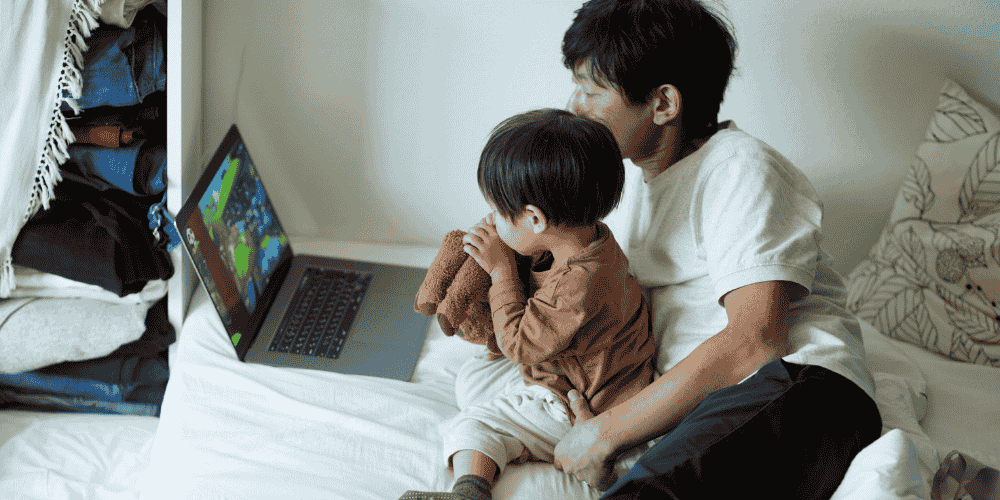We recently answered 6 of our most commonly asked questions by parents about their child’s Montessori education, including approaches to supporting healthy emotions, and how to continue the Montessori philosophy at home. Here are 6 tips Montessori parents need to know.
Navigating the School Transition Process or Transition to Montessori School
Students in a Montessori classroom experience a ‘normalization’ period in which they grow familiar with the different areas of the classroom, understand the daily routines and what activities are available to them, and become excited to interact with and learn alongside their peers.
Navigating the transition process to a Montessori school is different for every child because every child is unique. To make sure your child’s first day at a Montessori school goes as smoothly as possible, you should actively support the normalization process by positively communicating what they can expect to experience. This positive attitude is contagious: if you verbally and physically express to your child that you are excited for their first day of attending a Montessori school, chances are they will be too. Your child feeds off of your energy, so make sure it’s calm and engaged.
Talk with your Child about their First Day at a Montessori School
The first day of Montessori school is different for every child. Some children have never been to school before and there are others who have a very difficult time transitioning out of their regular routine at home and into a school environment.
When talking to your child about their first day at a Montessori school, let them know they will be attending a new school along with new teachers and classmates. Reassure your child that you will do your best to help familiarize them with the school, the classroom, and their future teacher by visiting the school or meeting their teacher ahead of time. You can do this by scheduling a tour, attending an open house, or communicating with the school administration to set up a visit. The more knowledge you have about your child’s day, the better you can prepare them by talking through what to expect.
At CMMS, we provide parents with daily student activity and schedules, information about our Montessori Links curriculum, and offer virtual and in-person tours. To learn more about our programming at CMMS, request a tour today.
Transitioning out of a Montessori School
If your child is leaving a Montessori school to transition to a regular school, they will face a few new changes from what they typically experience in a Montessori school. That might include getting used to eating in a large and/or noisy cafeteria full of students, riding a bus to and from school, or participating in gym class. Children who leave CMMS and attend other schools tend to be the leaders of their classroom, always eager to learn new material, and flexible in different learning environments. Our students adjust outside of a Montessori classroom because we have dedicated time to practical skills such as preparing them to be socially developed, confident, curious, and independent with a strong sense of self-esteem.
Remember, every child is different and so each student will adjust to a new school on their own timetable. As you listen and support them, be sure to acknowledge what your child is feeling or going through – it is important to be empathetic to your child and understand how they are feeling during the transition in order to find the best way to support them.
Encourage Montessori Learning at Home
Learning is not limited to a classroom – that’s why we encourage parents to continue Montessori learning at home! When Montessori learning is encouraged at home, there is a bridge of continuity from home to school which helps children feel secure and engaged in an ongoing learning journey.
You can encourage Montessori learning at home by using practical life skills through chores to build responsibility and independent habits, talking with your child about the Montessori curriculum they are currently studying, and/or creating spaces in your home that are a prepared and child-accessible environment which encourages children to engage with and care for the environment around them.
Incorporating what your child has learned at school into your daily routine will help them develop competence, independence, and confidence. Want to learn more about bringing Montessori into your home? Check out our Montessori at Home blog!
Guide your Child to Follow Directions at Home
Does your child follow directions at school, but not at home? While it can be frustrating for you and your child to work through this issue together, remember we all respond better when we feel we have input or choice in a situation we are affected by.
A reason your child may follow the directions at school and not home is because children experience peer pressure at school, which can be both positive and negative. At CMMS, our teachers guide and support students to cooperatively work together and collaborate on lessons and activities. When children see other children behaving in a positive way and reaping those positive rewards they are encouraged to model similar behaviors. In Montessori, almost everything has a consequence and while there is a lot of freedom, every freedom has a limit and the child is conscious of those boundaries. Children can trust an adult when they know there will be the same consequence every-time if something goes wrong: for example, if they drop and spill a drink, they will be asked to help clean it up. The child then learns that pattern of consequence and it is easier for the child to follow through with what is asked of them. Through patience, practice, and repetition we encourage students to consistently listen and respond to what’s asked of them.
You Can Prevent Tantrums
Tantrums can be very common in young children since they cannot always fully verbalize their emotions. Here are some simple ways you can help prevent your child from having a tantrum.
- If you sense your child is starting to have a tantrum you should stay calm and offer the option of a hug: this tangible connection to your love and support can help an emotional child to pause and regulate themselves.
- If your child is actively having a tantrum, you should stay calm, acknowledge your child’s emotions, and maintain safety boundaries. For example you might say, “I can see that you are very upset right now. It’s okay to be upset and angry, but it’s not okay to hit people. So I’m going to take a step back to stay safe, but I’m right here with you, and will give you a hug when you’re ready.” This process of naming emotions and identifying appropriate reactions takes time and patience as your child will begin to understand you are consistently there for them when they cannot verbally express their emotions and are a safe space to process what they’re feeling.
Toilet-Training: How we do it at CMMS
There is no universal age when all children are ready and able to use the toilet independently but in the Montessori environment we encourage even young children to be involved in the diapering and potty training process, to promote their understanding and eventual independence in the process. So even a 15 month old child might help pick up their diaper and bring it over to the changing table.
You will know when your child is ready to begin toilet training when they show interest in others’ use of the toilet, have a dry diaper for a longer period of time, verbalize their need to go, or have the ability to remove their own clothing to use the toilet.
Your child has shown interest in using the toilet, now what? It is time to encourage their independence by providing them with a child-sized toilet or a stool to reach the regular toilet, and placing clothes in the bathroom for them to change into if an accident occurs. These steps will boost your child’s sense of ownership in the process. Your child should be encouraged to wear clothing they can easily get in and out of: tight jeans, dresses with lots of layers,..ect are not a great idea during this training period. We also encourage families to incorporate toileting into their child’s routine to take advantage of the times they would normally need to go (ex: upon waking, before going outside, after coming in from outside, after lunch/before nap, etc).
Accidents happen and sometimes your child simply won’t make it in time. At CMMS, we encourage parents to stay calm and be reassuring to your child. We don’t want students to be embarrassed of an accident, so we simply say “I see you are wet. Let’s go get some dry clothes.” It can be helpful to keep a bucket in the bathroom for wet clothing, so your child can promptly change into clean, dry clothes and try again. If you remain consistent and don’t make a big deal out of the accident, toilet-training can continue on until it’s a normal part of their day.
Language and phrases that you can use for your child’s toilet-training are:
- “You’re so stable now. Let’s try standing for your diaper today.”
- “It is time to use the toilet.” (rather than asking, “Do you want to use the toilet”)
- ”Your pants look wet. It’s time to change your clothes.”
Consistency in language and routine between the home and school environment helps make completing the toilet training process easier and quicker, setting the students up for success. Consider incorporating our routine cards into your day to help encourage independence in your child’s daily routine.
We hope these 6 tips will help you become a confident Montessori parent!
Additional Resources
Have more questions? Prepare them for our Year-End Montessori Parent Q & A on May 1, 2023 at 6:00 PM and register to attend today!
For more information about how Children’s Manor & Magnet Montessori Schools can impact your child’s education and future, you can learn more about CMMS & schedule a tour or visit us at an upcoming open house.





